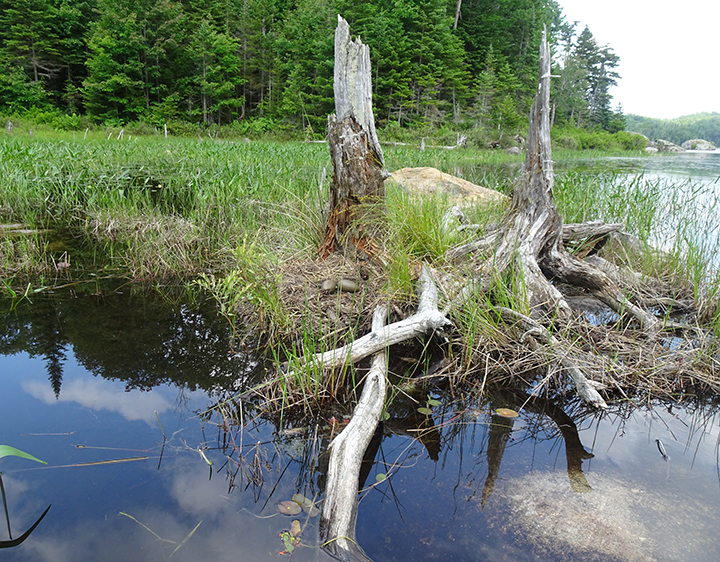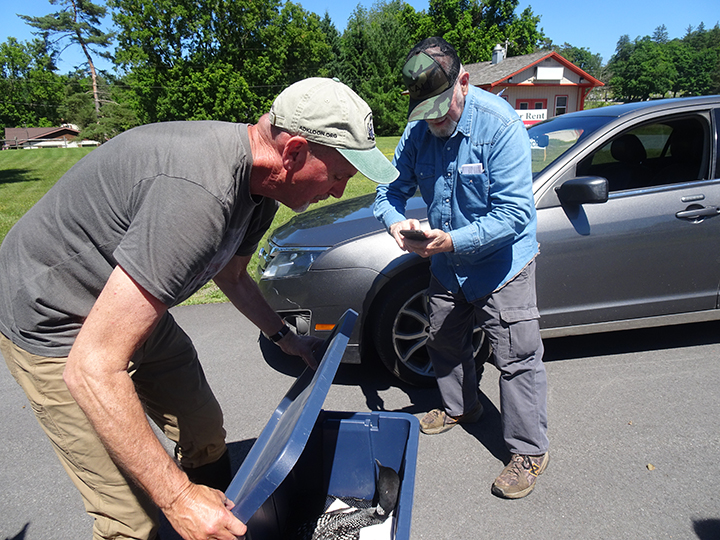
Outdoor Adventures with Gary Lee - Vol. 265
I was about to float the ARK this morning, the way it rained during the night. We had an inch in the gauge by the end of Saturday so there were some wet campers. Then the real downpours started and didn’t end until the middle of the night, giving us another two and three quarters inches which brought up water levels that the Loons couldn’t keep up with. I watched the pair on Fifth Lake fighting to save their nest during the beginning of the week when the water Regulating Board opened the gates on Sixth Lake Dam. The pair kept the eggs above water that time, but I think they got chilled a week earlier and they are more than a week overdue from hatching. This is their second year trying to nest there which filled in the last lake in the Fulton Chain to have loons nesting. They have been nesting on Eighth Lake for three years now. I don’t know how their nest made out or if they kept their eggs above water. When I came here in 1966 there were no Loons nesting or even seen on the Fulton Chain. DDT could have been the problem as that wasn’t band until 1972. DDT Blocks were placed in all the streams, foggers were used in many of the towns using DDT as well as aerial spraying over the towns all used to control the blackfly.
Raquette Lake was one town that didn’t use DDT. The then Conservation Department was conducting studies using Tree Swallow boxes in towns using DDT and in Towns like Raquette Lake who didn’t use DDT. They had lots of boxes in open areas along the Moose River in Old Forge and Thendara, the Inlet Golf Course and along South Inlet and Browns Tract Stream in Raquette Lake. The result was not much if any reproduction in the areas using DDT and lots of Tree Swallows fledged in the areas around Raquette Lake. After DDT was band 1972, I kept using the boxes that the Department had put up and made many more of my own. I still maintain several boxes in the area which raise lots of Tree Swallows and several Eastern Bluebirds. Many of the local nests this year had five and six young and they fledged most of them. I put bands on several of these birds before they left the boxes. Sometimes White Breasted Nuthatches, Black Capped Chickadees and House Wrens use these boxes, and you get a surprise when you open the box.
Last year I banded the five baby Eastern Phoebes under the porch in a nest. This year I came home one day, and an adult Phoebe was in the garage, and I caught it. It was exactly one year to the day that I banded the babies last year and it was one of those babies a male, which had returned, and it was trying to use the same nest from which it was raised. They are on eggs there and should hatch any day now.
Loon Rescue in Boonville Park Pond 6/28/24. The Adirondack Center for Loon Conservation got a notification that there was an adult Loon in the little pond in the park in Boonville on 6/27/24. Chris Liddle sent us pictures of the Loon and the pond which it couldn’t fly out of as the pond was too small. A John McKay also reported the Loon and tried to catch it when it got out of the pond, and it was out on RT. 12. He tried to catch it in a blanket, and it got back in the pond. We got a gill net brought down from Saranac Lake and Don Andrews picked it up in Blue Mountain Lake. Don and I got over to the pond around one in the afternoon and there was a couple Jim and Tammy Sexton from Rome fishing there. We asked if they had seen the Loon and they had. It was resting in the shade of some overhanging trees. Using the long handle landing net, I tried to catch it there, but it wasn’t going to be that easy and he swam out into the pond. We asked the couple if there were fish in the pond and there were some sunfish spawning right in front of us, so the Loon had some fish to eat.
We launched the canoe with Don paddling and me up front with the net. We made about six tries and he just wing rowed away from us each time we got close, so we went to plan B. That was to string the gill net across the pond in a narrow place. We asked Jim if he would help and there was a lady who writes for the Boonville Paper who was taking pictures who offered to help. I never did get her name, but you will see her article in the Boonville Paper, I’m sure. Don took the net in the canoe as I fed it out from this side of the pond. Don got it across and gave the end to Jim. He came back and got me, and the lady held this end of the net which was now all the way across the pond. The holders let the net go slack so it was under water. We herded the loon just like moving cattle in the corral. He was a little spooky when he came to the net, but he crossed it, and they pulled the top line out of the water. The Loon made one dive right into the net and we had him. Jim hauled him to shore, and I got out of the canoe and took him out of the net. We put him in the catch box on a couple towels and he was ours. We gathered up our equipment and a few photos were taken before we trucked the Loon unhurt to a pond in the Adirondacks. Sometimes plan B works and sometimes it doesn’t. Saved another Loon to live another day.
If the Loon nests didn’t hatch before the rains most were lost but that’s another story. See ya.
Photo above: Hidden Loon nest
